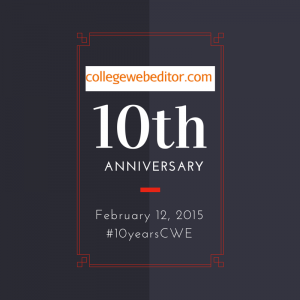This post is #4 in a series of 10 to celebrate the 10th anniversary of this blog while looking back at the past decade in higher ed digital marketing and communications.
Is email dead yet?
 In higher ed marketing and communications over the past decade, email has been the channel that kept on dying and… rising from its ashes
In higher ed marketing and communications over the past decade, email has been the channel that kept on dying and… rising from its ashes
At least that’s what you could think by looking at many posts and articles published over the years.
Yet, it’s around and thriving.
That’s not to say that expectations, challenges and best practices haven’t changed since 2005.
What’s really puzzling is why so many repeatedly announced its death (including me at some point :-).
Maybe it’s because of the love-hate relation we all have with our inbox, a daily reminder of what we want to do, what we thought we would need and what others expect from us.
Yet, email has been and is a powerful way to scale communications with many while still providing a personal touch when done right.
Did you get the email?
Email was widely misused 10 years ago by many higher ed institutions sending email blasts (don’t you love that term?) to many people (students, staff, alums, etc.) who didn’t request anything in the first place.
At that time – before the CAN-SPAM Act – having an email address was considered as an opt-in to receive ALL the emails of the world. :-)
Email had gone from an interpersonal communication channel to a marketing blasting machine overused and abused by spammers, marketers and well-intentioned but clueless communicators.
 That’s when institutions had to regulate the use of on-campus listerservs or group lists (you know the ones available in your Outlook institution directory). With the atomized nature of universities, the volume of emails increased very fast when faculty members and office managers chose email as their communication channel of choice.
That’s when institutions had to regulate the use of on-campus listerservs or group lists (you know the ones available in your Outlook institution directory). With the atomized nature of universities, the volume of emails increased very fast when faculty members and office managers chose email as their communication channel of choice.
The answer to this problem – as it’s the case for many in higher education – was to come up with a new email policy, an addendum to the IT use policy and the grand-mother of the social media policies that were all the raged a few years ago.
Sending gazillions messages lacking relevance, some universities and colleges started to experience email delivery issues. In their fight against, spammers major email service providers (Yahoo, AOL, hotmail and later Gmail etc.) started to blacklist some higher ed IP addresses. They were sending too many messages to look legit to the email spam filters.
Students had stopped checking their .edu inboxes forwarding their messages to their service of choice – which was considered as a real problem as these inboxes were central to make sure official communications had been officially communicated. Back in 2005, I suggested RSS as a way around in this post.
Has social media become the “difficult” platform email was?
Social media platforms like Facebook and Twitter seem to have follow a very similar path leading to a similar situation.
When you think about it, we face on social media the same issues we did with email:
- too many people have become publishers and sharers in our social media streams
- too many updates are posted
- the marketers have taken over the place
- filters have been set up to help users manage the load (well, we now call spam filters the Facebook Algorithm ;-)
Email newsletters are evil, no wait, now they are cool!
I believe this can explain the renaissance email newsletters have experienced outside of our industry and inside more recently over the past couple of years.
As you might know, I’ve sent a weekly email newsletter (not registered yet?) for the past 7 years. Bob Johnson has been doing his monthly newsletter for even longer. And, I bet he would agree with me in saying that for all those years, email newsletter have been a great way to share content with an interested audience of higher ed marketers and communicators.
As Ma’ayan Plaut posted this morning on her personal blog, email newsletters now even feel like the new social media.
 It looks like the cycle has come full circle and we’re starting over – that’s an example of what I meant in my 2nd post of this series when I talked about the underlining cycle.
It looks like the cycle has come full circle and we’re starting over – that’s an example of what I meant in my 2nd post of this series when I talked about the underlining cycle.
Technologies change, needs stay the same
Are we back to square 1? No, we never left.
I don’t think this is as much about technology or channels as it is about our need to have real personal connections and conversations.
The popularity of SnapChat, Instagram and other messaging apps among high school seniors and college students confirms that everybody wants to connect in a personal way with like-minded friends.
It’s our basic need to be talked to, not talked at.




“It’s our basic need to be talked to, not talked at.” / Email, SM, Email, SnapChat: the cycle of #highered comms http://t.co/AOJL6KWLGD
College Web Editor – Email, Social Media, Email, SnapChat: the cycle of communications in #highered #hesm: Thi… http://t.co/sKRXZmgGFJ
New post: College Web Editor – Email, Social Media, Email, SnapChat: the cycle of communications in #highered #hesm http://t.co/J48Emn2J9h
College Web Editor – Email, Social Media, Email, SnapChat: the cycle of communications in #highered #hesm http://t.co/lpokt29C7v
“Email, Social Media, Email, SnapChat: the cycle of communications in #highered #hesm” http://t.co/1bwywZYtyk by @karinejoly
RT @hatchsteph: “Email, Social Media, Email, SnapChat: the cycle of communications in #highered #hesm” http://t.co/1bwywZYtyk by @karinejoly
Email, Social Media, Email, SnapChat: the cycle of communications in #highered #hesm http://t.co/DkDnH2vieA http://t.co/YxoOPzeaUA
RT @higheredexperts: Email, Social Media, Email, SnapChat: the cycle of communications in #highered #hesm http://t.co/DkDnH2vieA http://t.c…
RT @higheredexperts: Email, Social Media, Email, SnapChat: the cycle of communications in #highered #hesm http://t.co/DkDnH2vieA http://t.c…
“Email was widely misused 10 years ago by many #highered institutions” Some are still doing it http://t.co/HJmuKtHxwE via @karinejoly